2019 TOYOTA YARIS gas type
[x] Cancel search: gas typePage 50 of 700
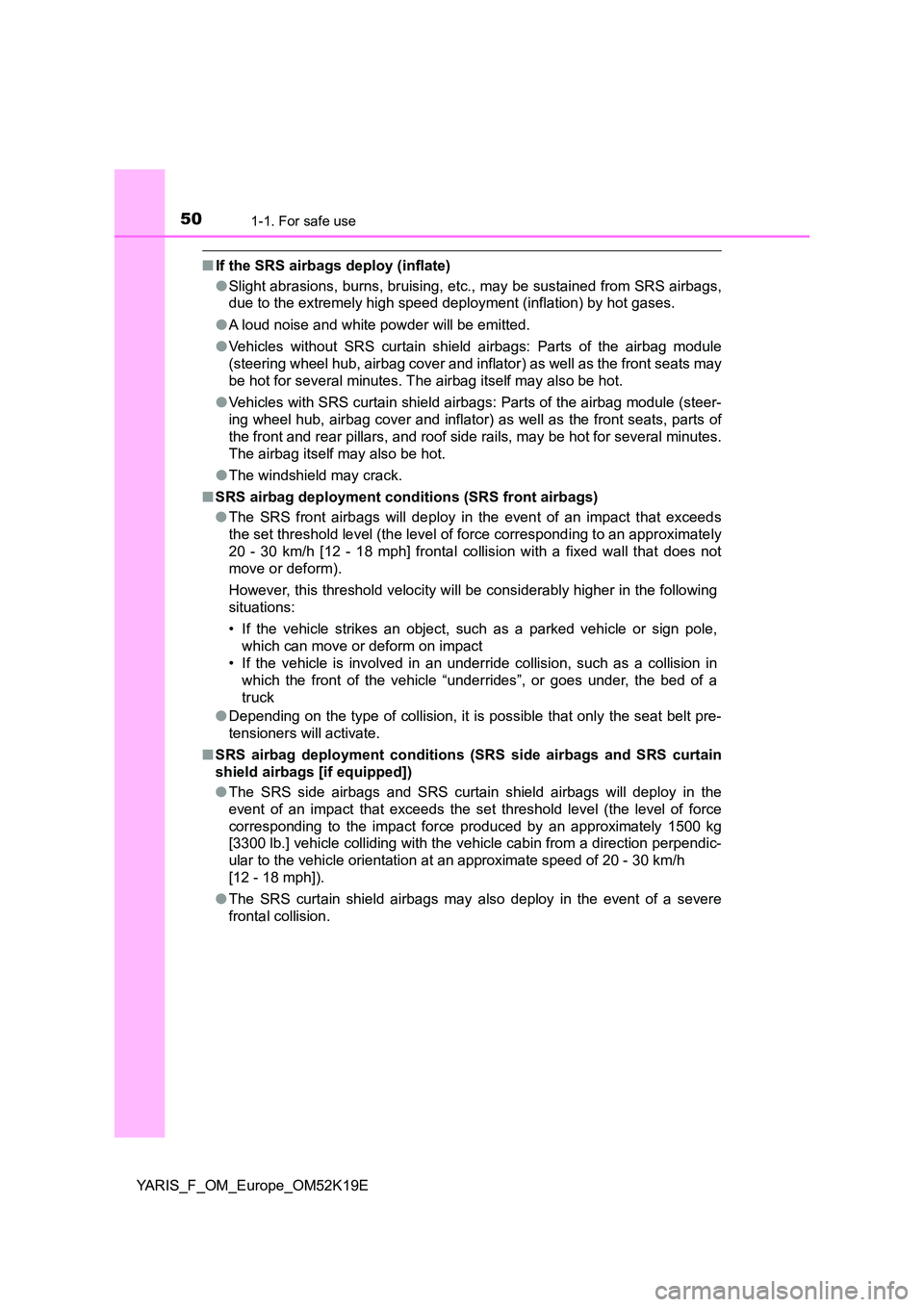
501-1. For safe use
YARIS_F_OM_Europe_OM52K19E
■If the SRS airbags deploy (inflate)
● Slight abrasions, burns, bruising, etc., may be sustained from SRS airbags,
due to the extremely high speed deployment (inflation) by hot gases.
● A loud noise and white powder will be emitted.
● Vehicles without SRS curtain shield airbags: Parts of the airbag module
(steering wheel hub, airbag cover and inflator) as well as the front seats may
be hot for several minutes. The airbag itself may also be hot.
● Vehicles with SRS curtain shield airbags: Parts of the airbag module (steer-
ing wheel hub, airbag cover and inflator) as well as the front seats, parts of
the front and rear pillars, and roof side rails, may be hot for several minutes.
The airbag itself may also be hot.
● The windshield may crack.
■ SRS airbag deployment conditions (SRS front airbags)
● The SRS front airbags will deploy in the event of an impact that exceeds
the set threshold level (the level of force corresponding to an approximately
20 - 30 km/h [12 - 18 mph] frontal collision with a fixed wall that does not
move or deform).
However, this threshold velocity will be considerably higher in the following
situations:
• If the vehicle strikes an object, such as a parked vehicle or sign pole,
which can move or deform on impact
• If the vehicle is involved in an underride collision, such as a collision in
which the front of the vehicle “underrides”, or goes under, the bed of a
truck
● Depending on the type of collision, it is possible that only the seat belt pre-
tensioners will activate.
■ SRS airbag deployment conditions (SRS side airbags and SRS curtain
shield airbags [if equipped])
● The SRS side airbags and SRS curtain shield airbags will deploy in the
event of an impact that exceeds the set threshold level (the level of force
corresponding to the impact force produced by an approximately 1500 kg
[3300 lb.] vehicle colliding with the vehicle cabin from a direction perpendic-
ular to the vehicle orientation at an approximate speed of 20 - 30 km/h
[12 - 18 mph]).
● The SRS curtain shield airbags may also deploy in the event of a severe
frontal collision.
Page 282 of 700
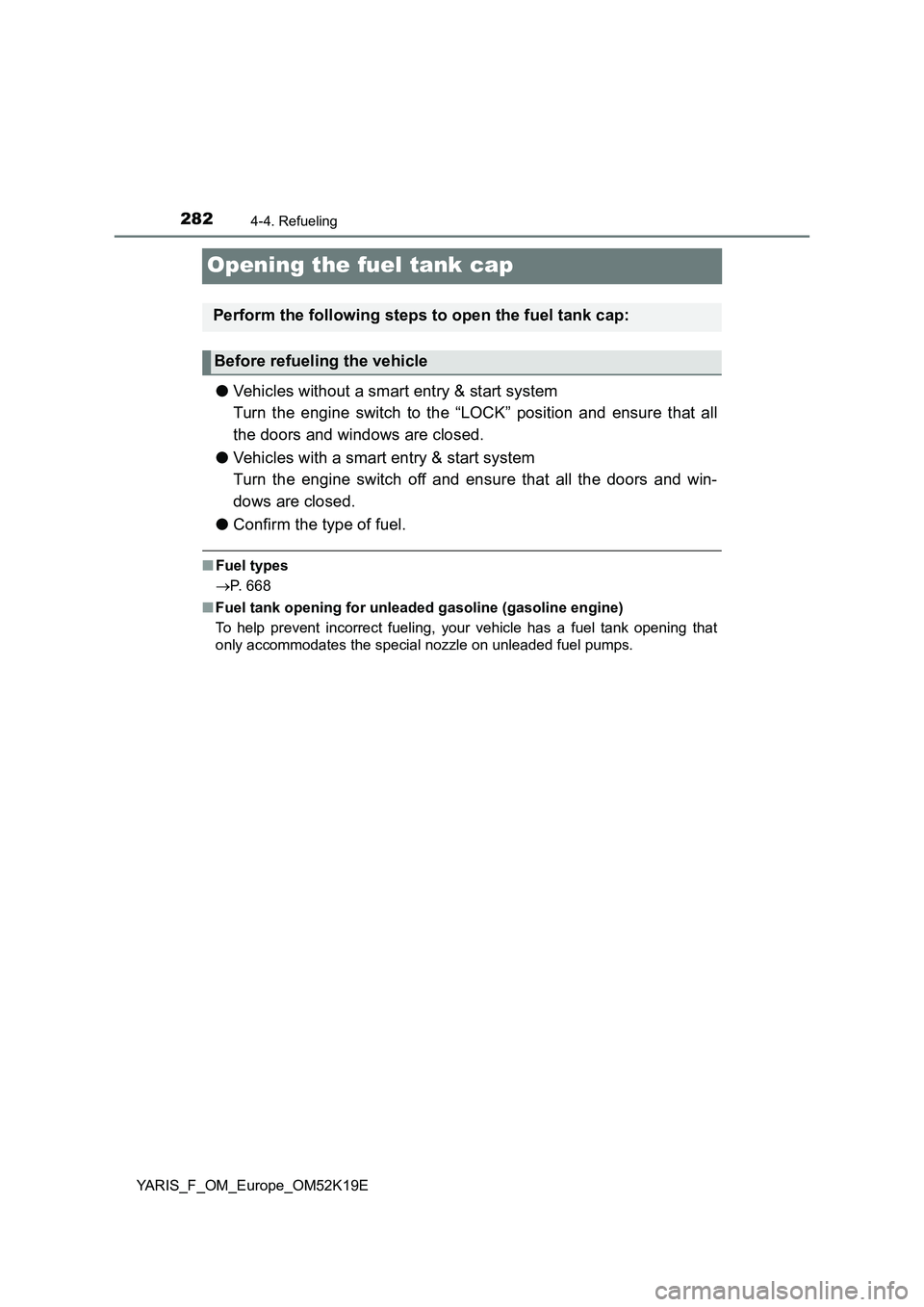
2824-4. Refueling
YARIS_F_OM_Europe_OM52K19E
Opening the fuel tank cap
●Vehicles without a smart entry & start system
Turn the engine switch to the “LOCK” position and ensure that all
the doors and windows are closed.
● Vehicles with a smart entry & start system
Turn the engine switch off and ensure that all the doors and win-
dows are closed.
● Confirm the type of fuel.
■Fuel types
P. 668
■ Fuel tank opening for unleaded gasoline (gasoline engine)
To help prevent incorrect fueling, your vehicle has a fuel tank opening that
only accommodates the special nozzle on unleaded fuel pumps.
Perform the following steps to open the fuel tank cap:
Before refueling the vehicle
Page 472 of 700
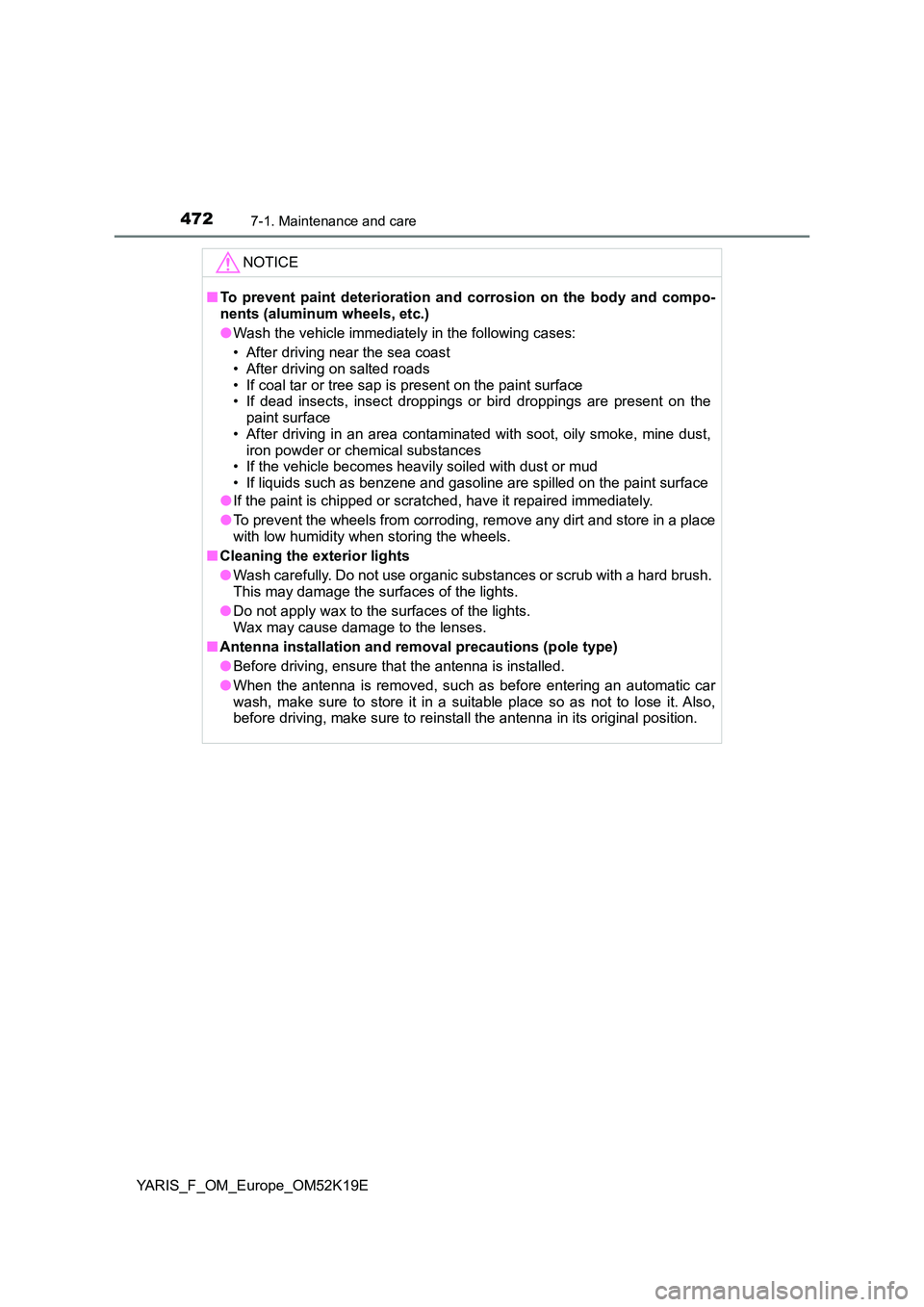
4727-1. Maintenance and care
YARIS_F_OM_Europe_OM52K19E
NOTICE
■To prevent paint deterioration and corrosion on the body and compo-
nents (aluminum wheels, etc.)
● Wash the vehicle immediately in the following cases:
• After driving near the sea coast
• After driving on salted roads
• If coal tar or tree sap is present on the paint surface
• If dead insects, insect droppings or bird droppings are present on the
paint surface
• After driving in an area contaminated with soot, oily smoke, mine dust,
iron powder or chemical substances
• If the vehicle becomes heavily soiled with dust or mud
• If liquids such as benzene and gasoline are spilled on the paint surface
● If the paint is chipped or scratched, have it repaired immediately.
● To prevent the wheels from corroding, remove any dirt and store in a place
with low humidity when storing the wheels.
■ Cleaning the exterior lights
● Wash carefully. Do not use organic substances or scrub with a hard brush.
This may damage the surfaces of the lights.
● Do not apply wax to the surfaces of the lights.
Wax may cause damage to the lenses.
■ Antenna installation and removal precautions (pole type)
● Before driving, ensure that the antenna is installed.
● When the antenna is removed, such as before entering an automatic car
wash, make sure to store it in a suitable place so as not to lose it. Also,
before driving, make sure to reinstall the antenna in its original position.
Page 476 of 700
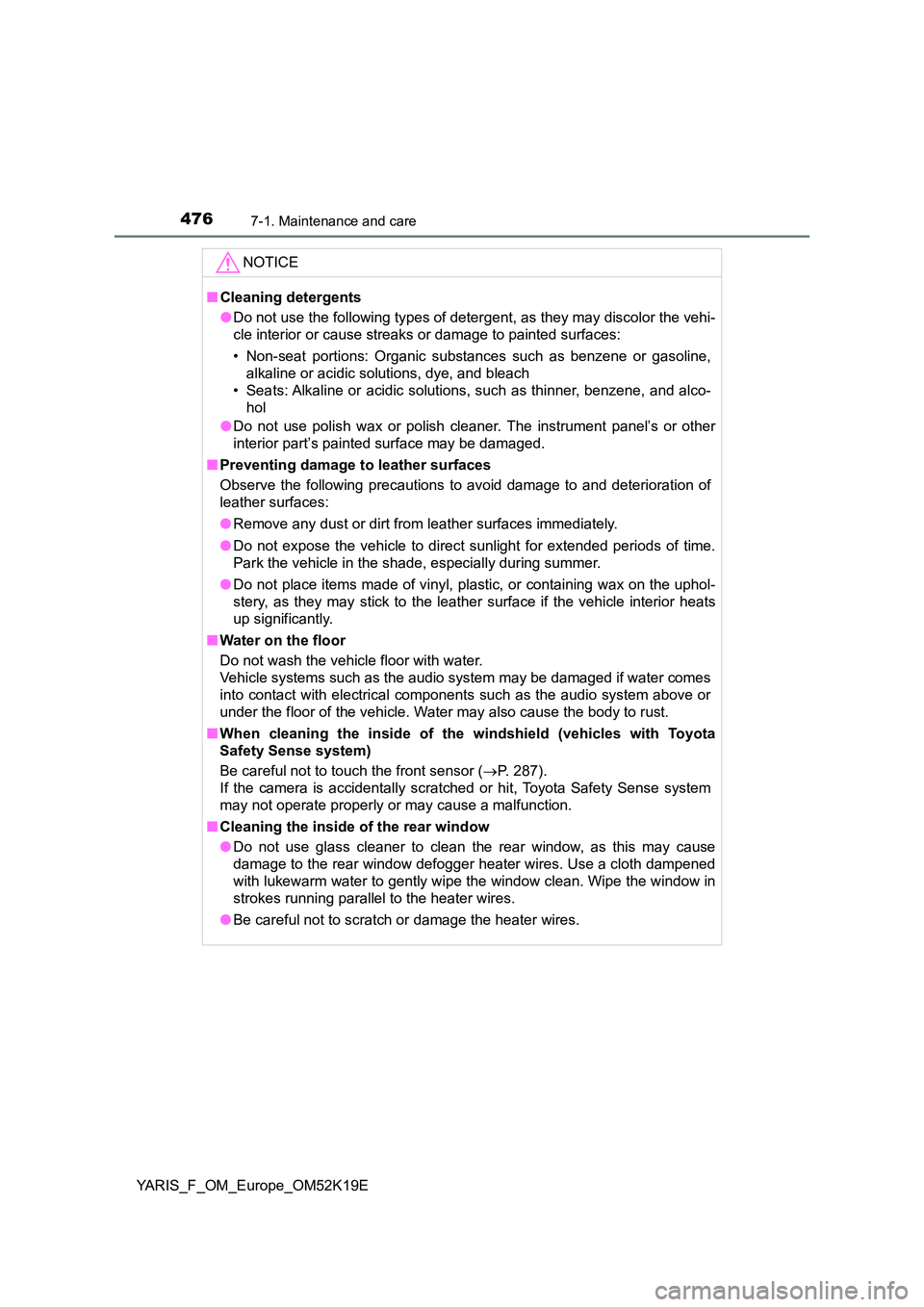
4767-1. Maintenance and care
YARIS_F_OM_Europe_OM52K19E
NOTICE
■Cleaning detergents
● Do not use the following types of detergent, as they may discolor the vehi-
cle interior or cause streaks or damage to painted surfaces:
• Non-seat portions: Organic substances such as benzene or gasoline,
alkaline or acidic solutions, dye, and bleach
• Seats: Alkaline or acidic solutions, such as thinner, benzene, and alco-
hol
● Do not use polish wax or polish cleaner. The instrument panel’s or other
interior part’s painted surface may be damaged.
■ Preventing damage to leather surfaces
Observe the following precautions to avoid damage to and deterioration of
leather surfaces:
● Remove any dust or dirt from leather surfaces immediately.
● Do not expose the vehicle to direct sunlight for extended periods of time.
Park the vehicle in the shade, especially during summer.
● Do not place items made of vinyl, plastic, or containing wax on the uphol-
stery, as they may stick to the leather surface if the vehicle interior heats
up significantly.
■ Water on the floor
Do not wash the vehicle floor with water.
Vehicle systems such as the audio system may be damaged if water comes
into contact with electrical components such as the audio system above or
under the floor of the vehicle. Water may also cause the body to rust.
■ When cleaning the inside of the windshield (vehicles with Toyota
Safety Sense system)
Be careful not to touch the front sensor ( P. 287).
If the camera is accidentally scratched or hit, Toyota Safety Sense system
may not operate properly or may cause a malfunction.
■ Cleaning the inside of the rear window
● Do not use glass cleaner to clean the rear window, as this may cause
damage to the rear window defogger heater wires. Use a cloth dampened
with lukewarm water to gently wipe the window clean. Wipe the window in
strokes running parallel to the heater wires.
● Be careful not to scratch or damage the heater wires.
Page 652 of 700
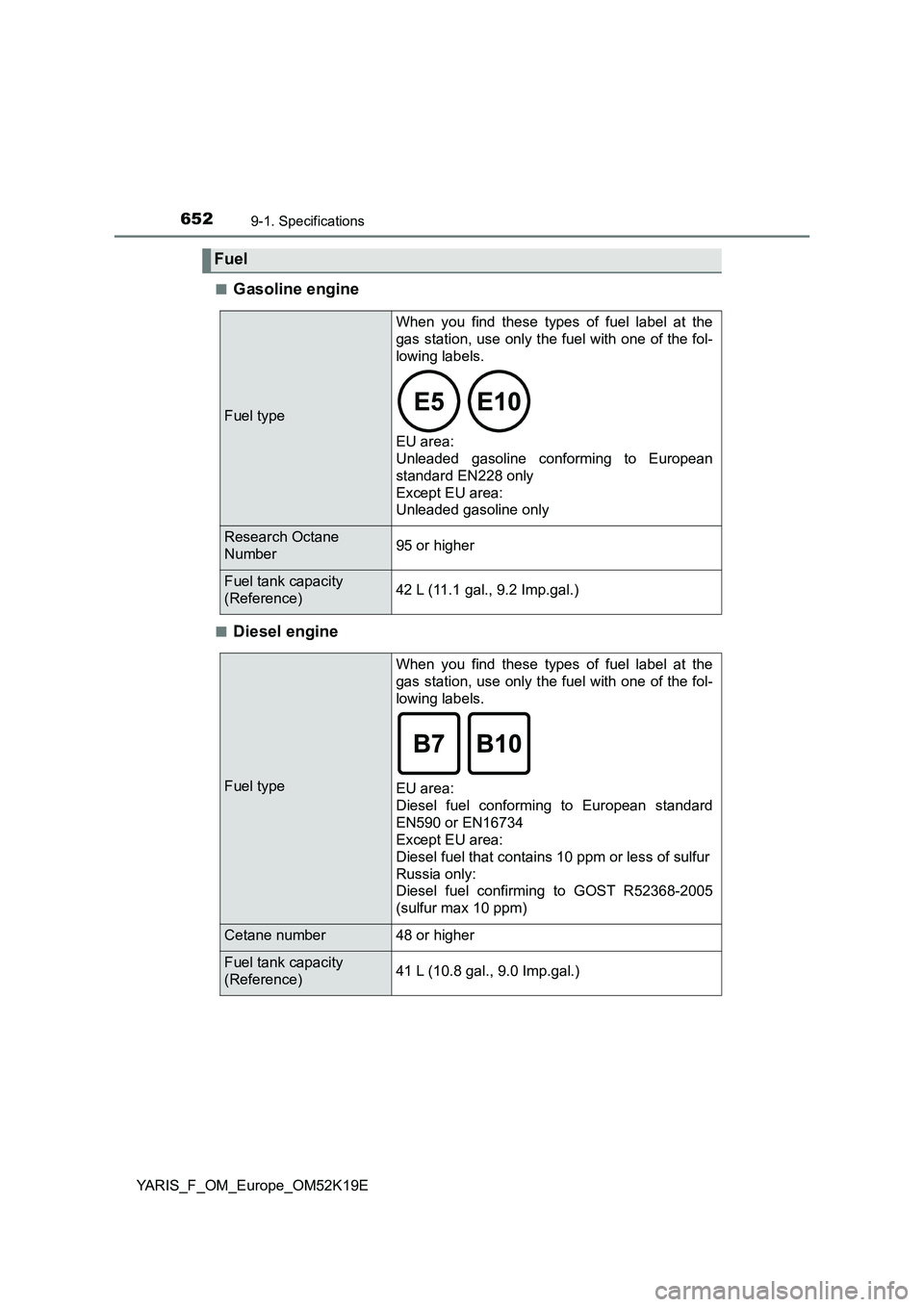
6529-1. Specifications
YARIS_F_OM_Europe_OM52K19E
■Gasoline engine
■Diesel engine
Fuel
Fuel type
When you find these types of fuel label at the
gas station, use only the fuel with one of the fol-
lowing labels.
EU area:
Unleaded gasoline conforming to European
standard EN228 only
Except EU area:
Unleaded gasoline only
Research Octane
Number95 or higher
Fuel tank capacity
(Reference)42 L (11.1 gal., 9.2 Imp.gal.)
Fuel type
When you find these types of fuel label at the
gas station, use only the fuel with one of the fol-
lowing labels.
EU area:
Diesel fuel conforming to European standard
EN590 or EN16734
Except EU area:
Diesel fuel that contains 10 ppm or less of sulfur
Russia only:
Diesel fuel confirming to GOST R52368-2005
(sulfur max 10 ppm)
Cetane number48 or higher
Fuel tank capacity
(Reference)41 L (10.8 gal., 9.0 Imp.gal.)
Page 659 of 700
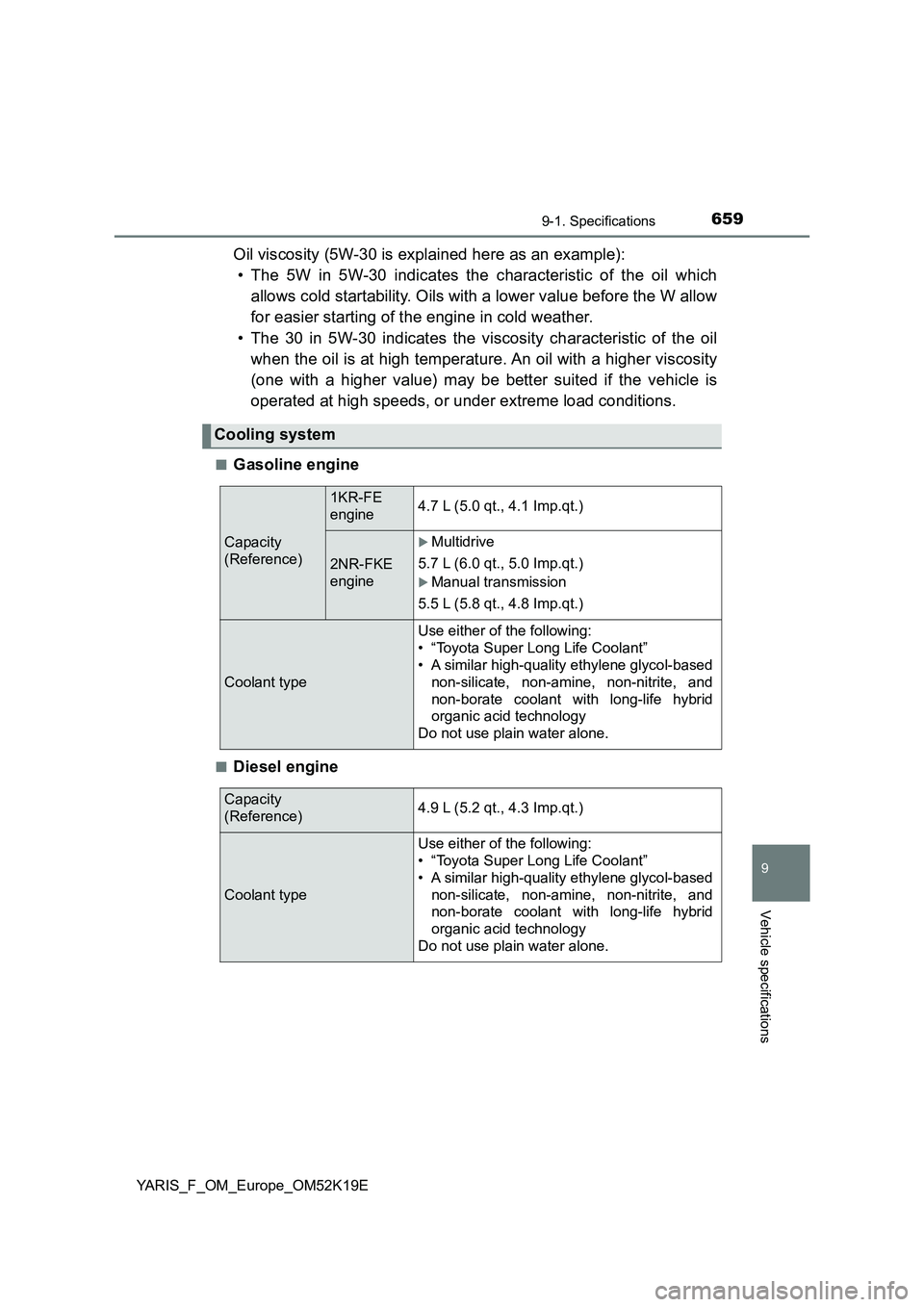
6599-1. Specifications
9
Vehicle specifications
YARIS_F_OM_Europe_OM52K19E
Oil viscosity (5W-30 is explained here as an example):
• The 5W in 5W-30 indicates the characteristic of the oil which
allows cold startability. Oils with a lower value before the W allow
for easier starting of the engine in cold weather.
• The 30 in 5W-30 indicates the viscosity characteristic of the oil
when the oil is at high temperature. An oil with a higher viscosity
(one with a higher value) may be better suited if the vehicle is
operated at high speeds, or under extreme load conditions.
■Gasoline engine
■Diesel engine
Cooling system
Capacity
(Reference)
1KR-FE
engine4.7 L (5.0 qt., 4.1 Imp.qt.)
2NR-FKE
engine
Multidrive
5.7 L (6.0 qt., 5.0 Imp.qt.)
Manual transmission
5.5 L (5.8 qt., 4.8 Imp.qt.)
Coolant type
Use either of the following:
• “Toyota Super Long Life Coolant”
• A similar high-quality ethylene glycol-based
non-silicate, non-amine, non-nitrite, and
non-borate coolant with long-life hybrid
organic acid technology
Do not use plain water alone.
Capacity
(Reference)4.9 L (5.2 qt., 4.3 Imp.qt.)
Coolant type
Use either of the following:
• “Toyota Super Long Life Coolant”
• A similar high-quality ethylene glycol-based
non-silicate, non-amine, non-nitrite, and
non-borate coolant with long-life hybrid
organic acid technology
Do not use plain water alone.
Page 660 of 700

6609-1. Specifications
YARIS_F_OM_Europe_OM52K19E
*: The fluid capacity is the reference quantity. If replacement is necessary,
contact any authorized Toyota retailer or Toyota authorized repairer, or any
reliable repairer.
Ignition system (gasoline engine only)
Spark plug
MakeDENSO FC16HR-Q8
Gap0.8 mm (0.031 in.)
NOTICE
■ Iridium-tipped spark plugs
Use only iridium-tipped spark plugs. Do not adjust the spark plug gap.
Electrical system
Battery
Open voltage* at 20 C
(68 F):
12.3 V or higher
If the specific voltage is lower than the standard
value, charge the battery.
(*: Voltage is checked 20 minutes after the
engine and all lights are turned off.)
Charging rates 5 A max.
Multidrive
Fluid capacity*7.5 L (7.9 qt., 6.6 Imp.qt.)
Fluid typeToyota Genuine CVT Fluid FE
NOTICE
■ Multidrive fluid type
Using Multidrive fluid other than “T oyota Genuine CVT Fluid FE” may cause
deterioration in shift quality, locking up of your transmission accompanied
by vibration, and ultimately damage the transmission of your vehicle.
Page 668 of 700
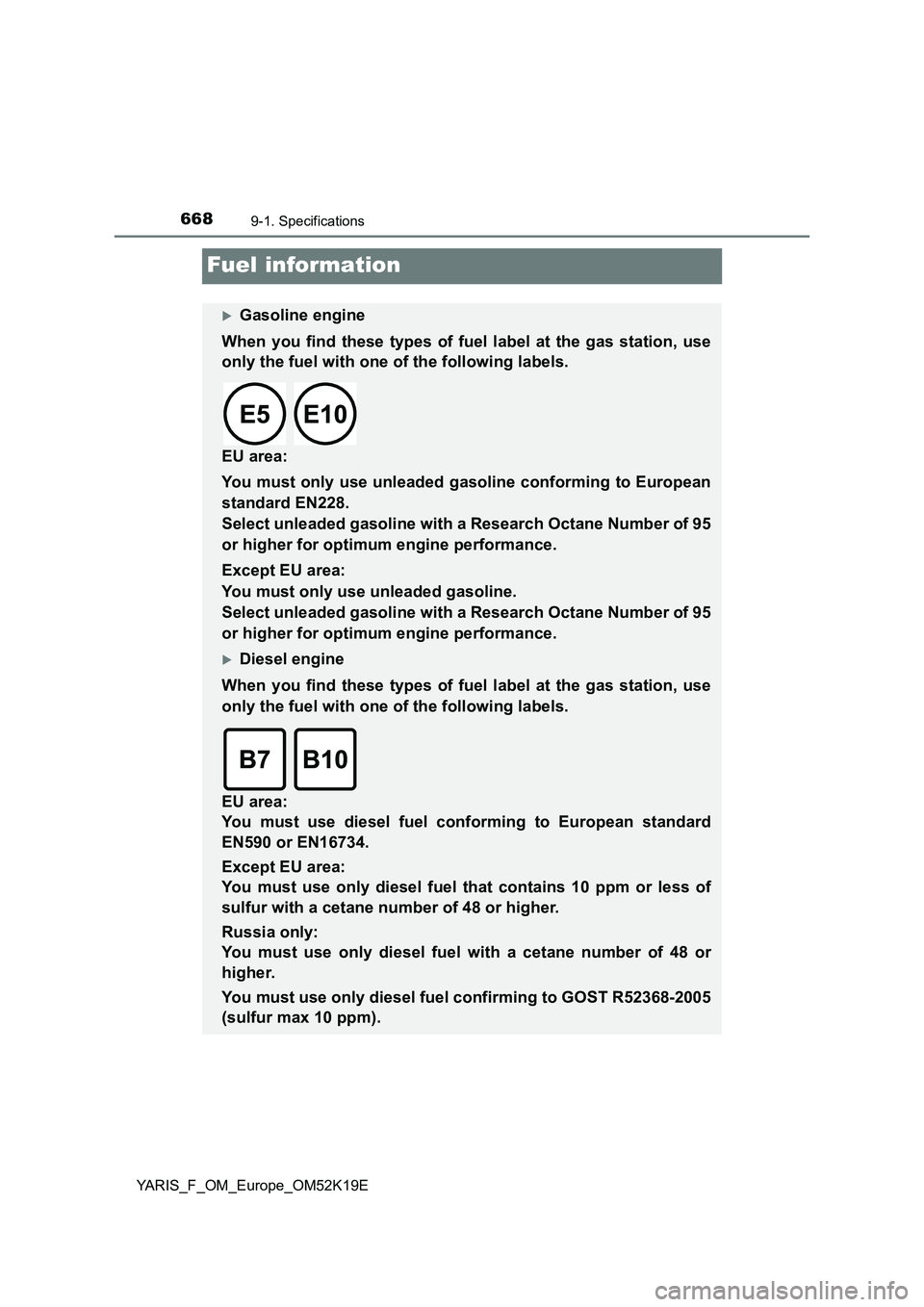
6689-1. Specifications
YARIS_F_OM_Europe_OM52K19E
Fuel information
Gasoline engine
When you find these types of fuel label at the gas station, use
only the fuel with one of the following labels.
EU area:
You must only use unleaded gasoline conforming to European
standard EN228.
Select unleaded gasoline with a Research Octane Number of 95
or higher for optimum engine performance.
Except EU area:
You must only use unleaded gasoline.
Select unleaded gasoline with a Research Octane Number of 95
or higher for optimum engine performance.
Diesel engine
When you find these types of fuel label at the gas station, use
only the fuel with one of the following labels.
EU area:
You must use diesel fuel conforming to European standard
EN590 or EN16734.
Except EU area:
You must use only diesel fuel that contains 10 ppm or less of
sulfur with a cetane number of 48 or higher.
Russia only:
You must use only diesel fuel with a cetane number of 48 or
higher.
You must use only diesel fuel confirming to GOST R52368-2005
(sulfur max 10 ppm).